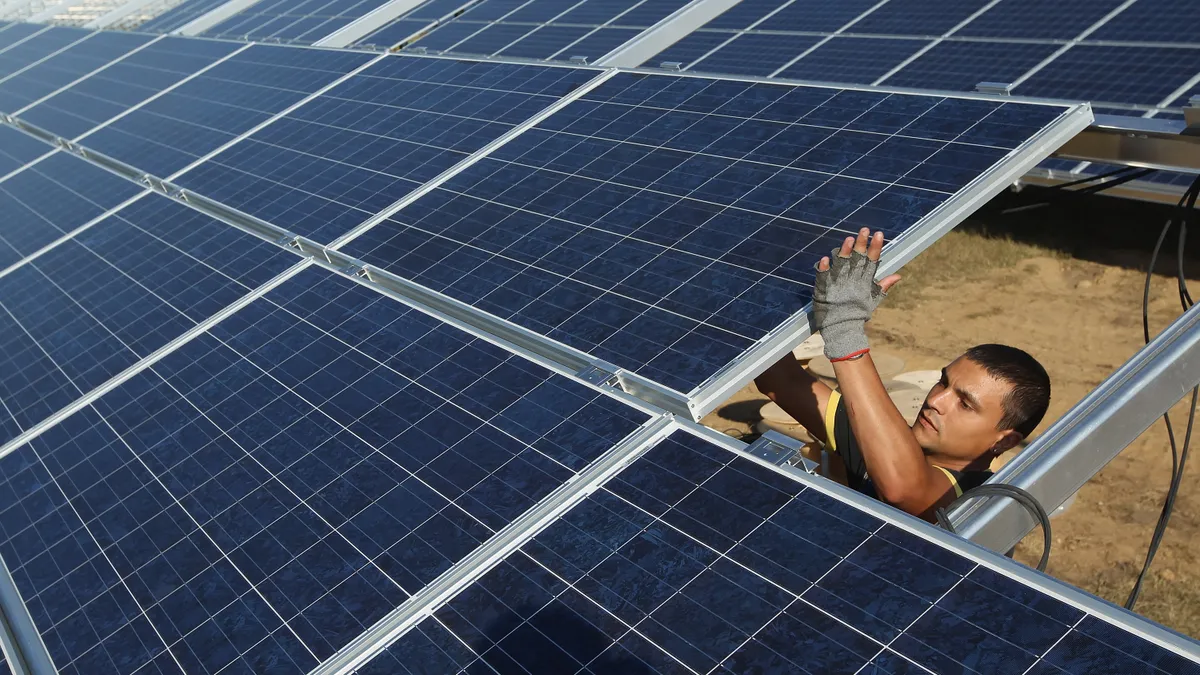Dive Brief:
- Dominion Energy is preparing to file its largest clean energy submission to date as part of Virginia's triennial review process, totaling $1.5 billion in investment, CEO Robert Blue said on the utility's second quarter earnings call Friday.
- The filing, due later this month, will include up to 1,100 MW of solar, either owned by the utility or through power purchase agreements and 100 MW of battery storage, on top of the utility's existing investments in offshore wind generation in the state, Blue said. Separately, Dominion recently filed the second phase of its grid transformation plans with Virginia regulators for the years 2022 and 2023, including $669 million in capital investment to facilitate new distributed energy resources.
- Blue also commented on the decision last month to terminate a planned sale of Dominion's Questar Pipeline natural gas infrastructure assets to Berkshire Hathaway Energy. Speaking to investors, Blue said that ending the deal was the "logical outcome," given circumstances around the transaction, including uncertainty about the Federal Trade Commission's approval.
Dive Insight:
In the utility's first quarter earnings call this year, Dominion executives said they would spend $26 billion over the next five years on emissions reduction for electricity production and gas distribution. That included $17 billion in zero-carbon generation and energy storage. The second quarter earnings call detailed some of the early steps Dominion will take to meet those lofty goals.
The Virginia filing is part of the utility's compliance with the Virginia Clean Economy Act, which requires Dominion to procure a combined 16 GW of solar and onshore wind by the end of 2035. The Bureau of Ocean Energy Management last month granted a notice of intent for the 2.6 GW Coastal Virginia offshore wind project, kicking off the federal permitting review process.
South Carolina regulators last month also approved Dominion's 15-year Integrated Resource Plan (IRP), which calls for shutting down the utility's coal-fired power plants within the next decade. Blue said the decision, which came after months of back and forth with advocates and regulators, "provides significant customer benefits" and "allows all parties to turn the page and focus on South Carolina's bright energy future."
In response to investor questions about the multi-trillion dollar infrastructure packages working through Congress, Blue said executives are "closely watching" and see "real possibilities" for clean energy in the bill. Specifically, Blue said he was in favor of the bill's R&D spending that could support green hydrogen and small modular reactors, as well as manufacturing credits for wind and solar resources.
Blue also touted Dominion's efforts to reduce the carbon footprint of its natural gas distribution services, which remain a core part of the utility's business. Dominion is modifying operations and maintenance procedures, replacing aging infrastructure to reduce leaks and more efficiently deliver gas. Dominion is also seeking approval for a pilot program in Utah that would allow residential customers to purchase carbon offsets for their use of gas from Dominion's network.
Blue also said that a hydrogen blending pilot at Dominion's Training Academy in Utah is "performing in line with expectations," well enough that it will be expanded to other markets. The company filed for approval of a blending pilot in North Carolina and is looking at the next steps for one in Ohio.
Overall, Dominion reported $628 million in earnings for the three-month quarter, compared to $630 million in earnings in the same period in 2020. Net income was only $285 million for the quarter, reflecting economic hedging activities, changes in the value of the nuclear decommissioning trust fund and Questar Pipelines' contribution, the company said in a release.
Although the Questar sale was expected to close by the end of the year, Blue said the "facts and circumstances surrounding that transaction" made it more efficient to end the discussions. Berkshire Hathaway had been set to pay $4 billion in cash and assume $5.7 billion in debt for the infrastructure, including the 2.5 Bcf/d interstate Questar Pipeline in Utah, Wyoming and Colorado and the Clay Basin underground storage facility. Blue said on the earnings call that additional gas transmission storage assets had been sold to Berkshire and that the utility remained "pretty happy with where we're going" with the Questar assets.














